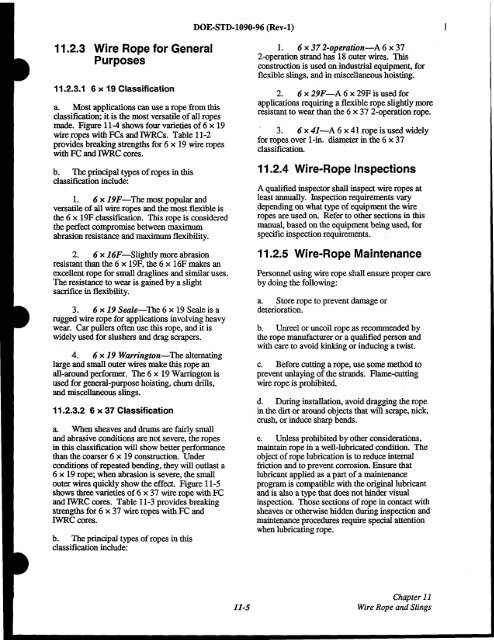DOE-STD-1090-96, DOE Standard Hoisting and Rigging Manual ...
DOE-STD-1090-96, DOE Standard Hoisting and Rigging Manual ...
DOE-STD-1090-96, DOE Standard Hoisting and Rigging Manual ...
You also want an ePaper? Increase the reach of your titles
YUMPU automatically turns print PDFs into web optimized ePapers that Google loves.
<strong>DOE</strong>-<strong>STD</strong>-I090-<strong>96</strong> (Rev-I)11.2.3 Wire Rope for GeneralPurposes11.2.3.1 6 x 19 Classificationa Most applications can use a rope from thisclassification; it is the most versatile ofall ropesmade. Figure 11-4 shows four varieties of 6 x 19wire ropes with FCs <strong>and</strong> IWRCs. Table 11-2provides breaking strengths for 6 x 19 wire ropeswith FC <strong>and</strong> IWRC cores.b. The principal types ofropes in thisclassification include:1. 6 x 19F-Themost popular <strong>and</strong>versatile of all wire ropes <strong>and</strong> the most flexible isthe 6 x 19F classification. This rope is consideredthe perfect compromise between maximumabrasion resistance <strong>and</strong> maximum flexibility.2. 6 x 16F-Slightlymore abrasionresistant than the 6 x 19F, the 6 x 16F makes anexcellent rope for small draglines <strong>and</strong> similar uses.The resistance to wear is gained by a slightsacrifice in flexibility.3. 6 x 19 Seale-The 6 x 19 Seale is arugged wire rope for applications involving heavywear. Car pullers often use this rope, <strong>and</strong> it iswidely used for slushers <strong>and</strong> drag scrapers.4. 6 x 19 Warrington-The alternatinglarge <strong>and</strong> small outer wires make this rope anall-around performer. The 6 x 19 Warrington isused for general-purpose hoisting, chum drills,<strong>and</strong> miscellaneous slings.11.2.3.2 6 x 37 Classificationa. When sheaves <strong>and</strong> drums are fairly small<strong>and</strong> abrasive conditions are not severe, the ropesin this classification will show better performancethan the coarser 6 x 19 construction. Underconditions ofrepeated bending, they will outlast a6 x 19 rope; when abrasion is severe, the smallouter wires quickly show the effect. Figure 11-5shows three varieties of6 x 37 wire rope with FC<strong>and</strong> IWRC cores. Table 11-3 provides breakingstrengths for 6 x 37 wire ropes with FC <strong>and</strong>IWRCcores.b. The principal types ofropes in thisclassification include:1. 6 x 372-operation-A 6 x 372-operation str<strong>and</strong> has 18 outer wires. Thisconstruction is used on industrial equipment, forflexible slings, <strong>and</strong> in miscellaneous hoisting.2. 6 x 29F-A 6 x 29F is used forapplications requiring a flexible rope slightly moreresistant to wear than the 6 x 37 2-operation rope.3. 6 x 41-A 6 x 41 rope is used widelyfor ropes over I-in. diameter in the 6 x 37classification. .11.2.4 Wire-Rope InspectionsA qualified inspector shall inspect wire ropes atleast annually. Inspection requirements varydepending on what type ofequipment the wireropes are used on. Refer to other sections in thismanual, based on the equipment being used, forspecific inspection requirements.11.2.5 Wire-Rope MaintenancePersonnel using wire rope shall ensure proper careby doing the following:a. Store rope to prevent damage ordeterioration.b. Unreel or uncoil rope as recommended bythe rope manufacturer or a qualified person <strong>and</strong>with care to avoid kinking or inducing a twist.c. Before cutting a rope, use some method toprevent unlaying ofthe str<strong>and</strong>s. Hame-cuttingwire rope is prohibited.d. During installation, avoid dragging the ropein the dirt or around objects that will scrape, nick,crush, or induce sharp bends.e. Unless prohibited by other considerations,maintain rope in a well-lubricated condition. Theobject ofrope lubrication is to reduce internalfriction <strong>and</strong> to prevent corrosion. Ensure thatlubricant applied as a part ofa maintenanceprogram is compatible with the original lubricant<strong>and</strong> is also a type that does not hinder visualinspection. Those sections ofrope in contact withsheaves or otherwise hidden during inspection <strong>and</strong>maintenance procedures require special attentionwhen lubricating rope.11-5Chapter 11Wire Rope <strong>and</strong> Slings
















